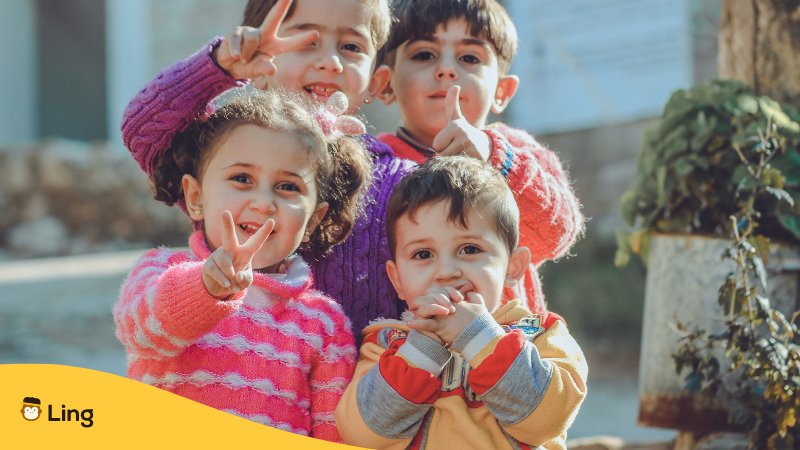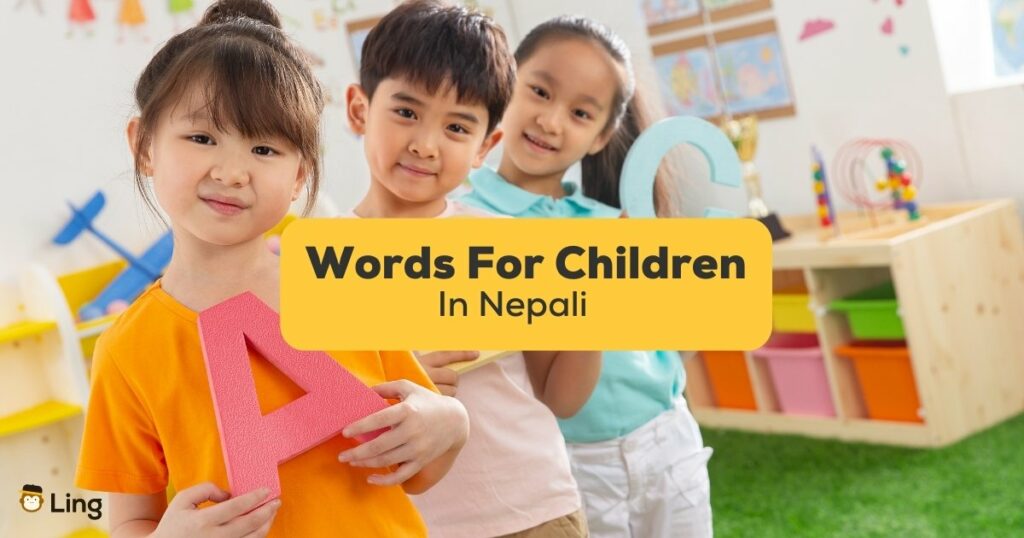Are you struggling to wrap your tongue around Nepali words as an adult? Well, research says that adults have difficulty catching new languages and bringing fluency with new sound systems and grammar. However, it is the opposite for children. So, if you want to save some struggle for your child when they grow up, now is the right time to make them known to the world of languages.
Kids have the power to catch new languages effortlessly and learn way faster than adults do. If you are willing to introduce your little one to the exquisite Nepali language, this blog, filled with all the Nepali words for children, will save your day!
Nepali is a lovely language that many language learners are striving for. The language is embedded with the Nepali culture, and once you get familiar with it, you get insights into the traditions of the Nepali world. In case you live in Nepal or are planning to settle down, teaching your kid the native language with some of the basic Nepali words for children is the right parenting step to take.
Exposing yourself and your child to such a vibrant language will make your stay in Nepal truly blissful and give you a hint of the nation’s authentic reality. So, if you are interested to learn basic Nepali words, continue reading below!
Common Nepali Words For Children
Let us begin with common phrases and words used by children in their daily lives with English translations. Especially if you are new to the country, these phrases will help interact with the locals and make a stunning impression on your parenting and child’s skills.
1. Hello!
The first and most important thing your child needs to learn is how to greet people. Nepal is a cultural place where children are taught manners and etiquette from a tender age. You will see even a five-year-old bowing and greeting with grace to their elders and friends.
So, the word Namastē is used for greeting someone when they meet them for the first time. While only uttering the word would suffice, you can also teach your child to take their palms together in front of their chest and bow from the head when they say Namastē. That is the traditional way of greeting someone in Nepal, especially when the younger one is greeting their elders.
2. My Name Is…
The first thing that adults ask kids is names. So, to smartly respond to such a question, Mērō nāma… is the right phrase to use. It is a basic phrase in the Nepali books that your child will need in different settings. From meeting elderly people to introducing themselves on the first day of their school, this phrase must be saved in the child’s memory. Especially if your child is getting a new admission to a Nepali school, they will need this to introduce themselves during the principal’s interview.
3. I Am From…
Similarly to the previous phrase, Ma bāṭa… is another common phrase your child must know while learning Nepali. Although it is already common in school interviews and casual settings, if you are a foreigner in the country, this phrase is inevitable. There is a chance that random people might come up and ask your child about their locality and place. So, to help your kid communicate without getting baffled, this is a must.
4. I Am…Years Old
Being a child, Ma…Varṣa purānō chu phrase is a must-know. Especially when locals see a kid talking in Nepali, they will flood the kid with questions concerning their age. So, to politely and gently answer such questions, this is the right phrase to use. Once again, this question is essential if your child is joining a Nepali school for the first time.
5. I Study In Class…
If you want your child to know more introductory phrases, Ma kakṣāmā paḍhchu… is an important one. Even in school, it will be of help when any teacher or parent asks them about their class. This will also help your kid make conversations with their classmates and make new friends on the very first day of school in Nepal.
6. Thank You
When I say Nepali kids are cultured from the very beginning, they know how to say thank you, when to thank someone, and how to be thankful. Politeness and courtesy are positive manners that every parent in Nepal looks forward to teaching their kids. So, if you want your kid to show some generous behavior, it is important to teach them how to say Dhan’yavāda.
Not only the word, but it is also essential to teach them that one should always be thankful when they receive something from someone. And an important information regarding Nepali etiquette is, always receive things with both hands or the right hand. It is rude to use your left hand to receive gifts and graces.
7. Sorry
As we talk about manners, another important word in Nepali for children is Māpha garnuhōs. Since your child is still young, locals would not mind if they unintentionally offend or hurt someone. However, it is only correct parenting to teach your tiny tot how to be respectful and apologetic. And to sound so, this word is must know. Learning this will surely make him abide by the rules of nature and follow a path of righteousness.

More Children’s Phrases In Nepali
Here is a list of more phrases for children to help your little one understand the Nepali alphabet better.
Perks Of Being Bilingual At An Early Stage
While learning new languages becomes an asset when one is traveling or settling in a new country, it also helps in a case otherwise. In this globalized world where there are no boundaries of culture and a lot of cross-cultural communication, learning Nepali can be a beneficial choice for your kid.
#1 Cognitive Development
One of the most important benefits of being a bilingual kid is that it strengthens cognitive abilities. When a kid is exposed to more than one language, and they learn to catch up at a tender age, it leads to more flexibility and creativity. The little ones become more open-minded and curious, and they find it interesting and easier to engage in different tasks. Early learning, easy teaching, and the right sources can allow a child’s brain development with high mental dexterity, which helps the child work on different tasks with executive smoothness, simultaneously.
#2 Better Education
Another research has mentioned that being bilingual in early learning helps the child be inclined towards educational activities more. They perform better in tasks and find it enjoyable and feasible to learn other languages that are added to their course. According to research conducted by the University of Washington, bilingual kids perform better in writing and reading assessments. It develops with improved cognitive ability, which further helps the kid with critical thinking and reasoning.
#3 Social Outcome
The most beneficial fact of all is socialization. Being bilingual makes your kid more open to people of a wider range and allows them to make bonds faster through communication. Especially if your kid is in an international school where there are children from different regions and nationalities, bilingualism can help them adapt and learn more quickly. It helps in making the child more empathetic, understanding, and confident. It allows the kid to move forward and appreciate others’ existence, and such behavior can bring a lot of healthy bonds and company.
#4 Career Advantage
As I already mentioned, learning new languages is much more difficult in adulthood than during childhood. So, if you make your child learn a new language and make them bilingual at an early stage, it will help them develop fluency and speech when they grow older.
And research says that in this world of global job opportunities, being bilingual helps a person find jobs easily. It opens doors in fields like business, diplomacy, and even tourism. In fact, according to the American Council on the Teaching of Foreign, it has found that being bilingual or multilingual helps is increasing a student’s salary potential. Many jobs in the world are in search of multilingual people.

How To Improve Nepali Skills
Now that you know how essential it is to become bilingual and start learning from an early stage, let me help you with some ways through which learning can be easy.
#1 Nepali Picture Book
The Nepali alphabets picture book is one of the best ways to teach your kid how to speak Nepali. You will find many books with colorful pictures and drawings that will make learning fun for your child. Since they have colorful pictures and words, it makes learning more engaging and interesting.
#2 Nepali Youtube Channels
Nowadays, you can easily find youtube channels created for children to learn new languages. Search for Nepali words and alphabets, and your child will surely get engaged with the videos very soon. Some channels provide rich multimedia content with attractive photos and videos. The following features can become a true gem for your kids and make language learning their best hobby.
Learn Nepali With Ling App
As we are talking about resources to help your child learn the Nepali language, we cannot miss out on the Ling app. Language learning apps are a modern and easy way of making your child learn something new and unique. And in such cases, the Ling app is the most revolutionary app that will make your child a pro-Nepali speaker in no days.
It is an easy-to-use and flexible language-learning app that provides content in 60+ languages and covers different topics like food, hobbies, grammar, culture, etc. Once you download the app from Appstore or Playstore, your child will find a new language tutor, as the app features an AI chatbot, which engages one with interactive lessons. So, instead of paying extra for an individual tutor, the chatbot will do the job and help your child improve communication skills and retention ability.
The best part is that Ling has a lot of puzzles, quizzes, and mini-games that can grab the attention of kids. So, if you want your child to learn Nepali with Ling, download the app now and start a fun learning journey right away.



































































